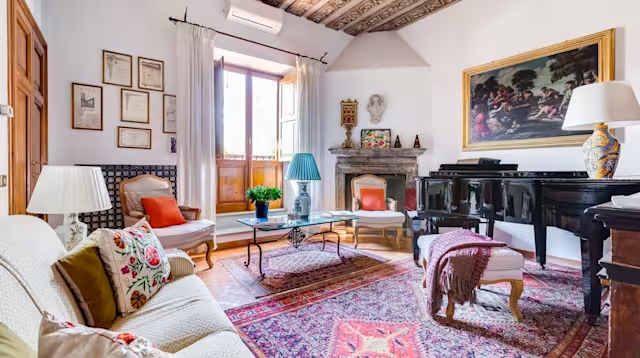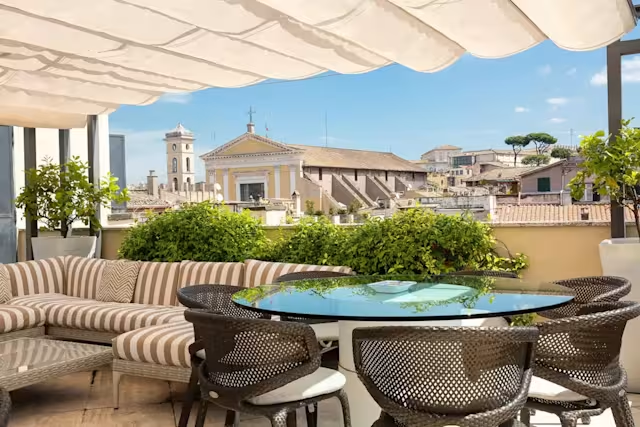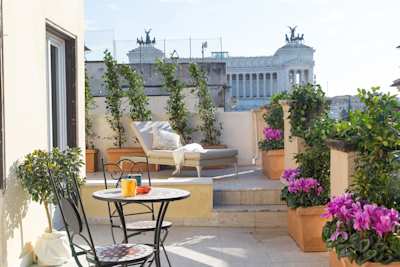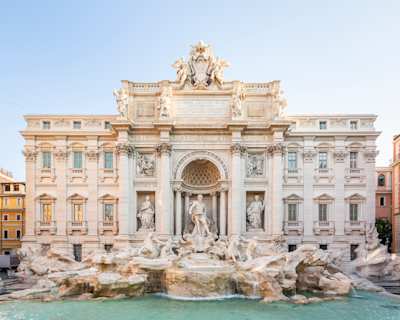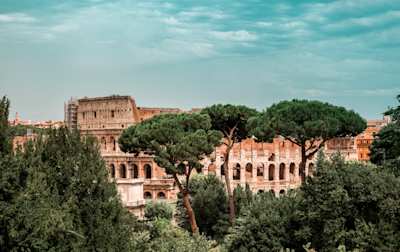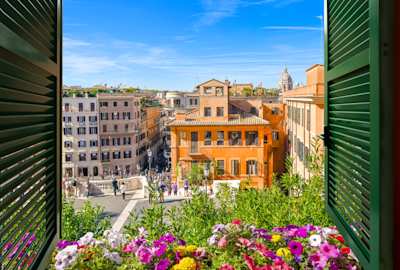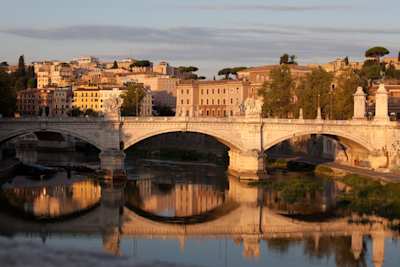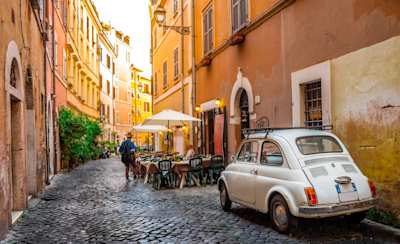9 Things To Do in Rome: Your Must-See List for the Eternal City
With culture and food fit for emperors, here’s what to do when in Rome
~
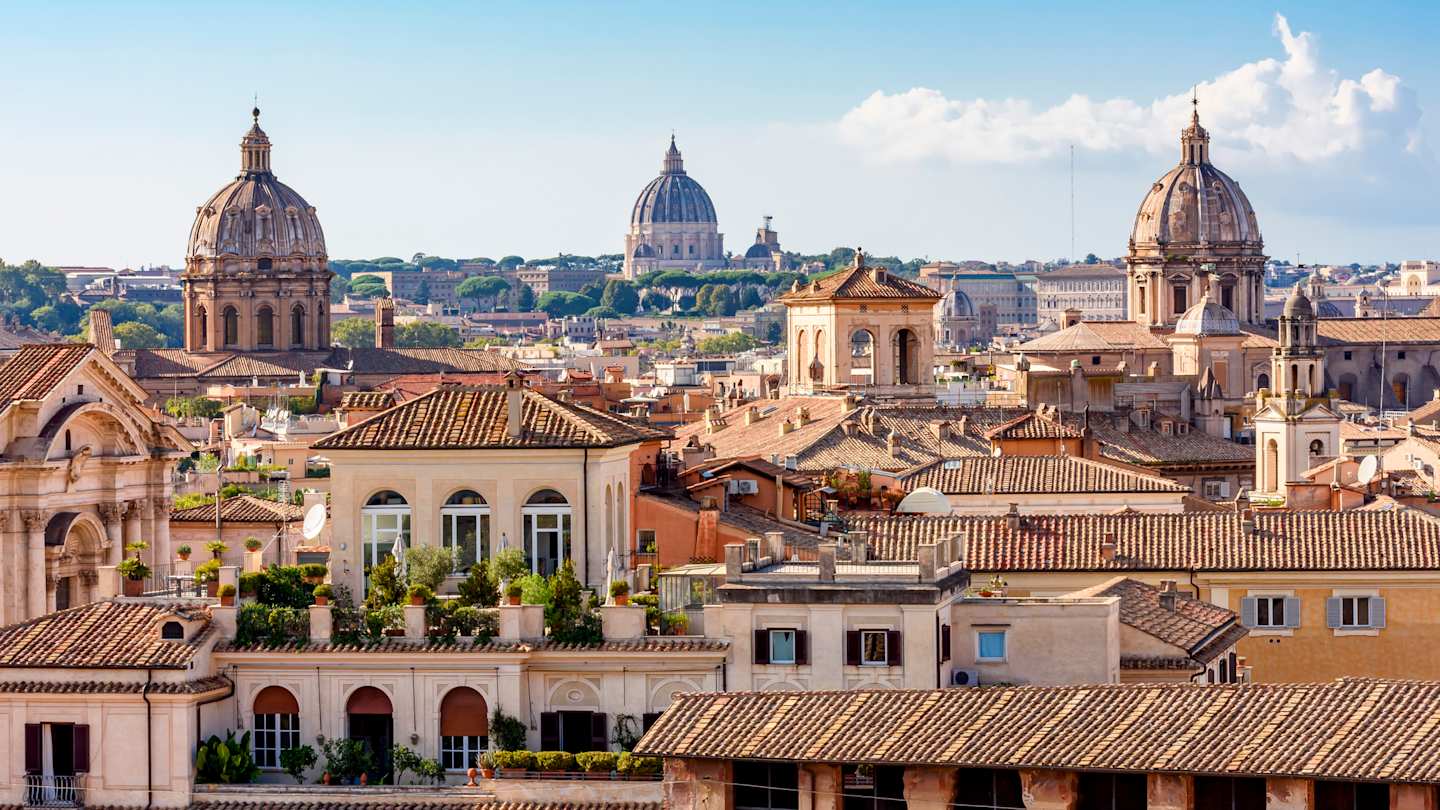
We have a suspicion that ‘things to do in Rome’ may well be one of the most Googled search terms when it comes to travel in Europe. To save you sifting through all the waffle and confusion, our Plum Guide experts have put together this very useful, all-in-one guide of things to do in Rome. While there are some obvious classics such as the Colosseum and Vatican, it’s truly one of Europe’s greatest cities and you don’t want to miss out on some of the other, lesser-known activities. Grab a pen and notepad and read on for our top recommendations and expertise.
Tick a visit to the Colosseum off your bucket list

The Colosseum with clear blue sky and clouds and tourists queuing in front, Rome
Paris has the Eiffel Tower, London has Big Ben and Berlin has the Brandenburg Gate. For Rome, there is no greater icon and landmark than the Colosseum. Despite its popularity (the queues and crowds can be shocking at times), a visit here for any first-time visitor is a must. Sometimes, iconic buildings can feel a little underwhelming given all the hype they receive, but the Colosseum really delivers. This is the largest ancient amphitheatre ever built and, despite its age and crumbling facade, it remains the largest standing amphitheatre in the world.
Whether you’re exploring on your own or taking a guided tour, bring your camera and tick this off the bucket list. As you make your way around, you’ll learn more about the history and culture of Rome, including exactly why up to 80,000 spectators found it so appealing to watch gladiators and lions rip each other’s heads off. If a little gruesome, it’s an impressive architectural wonder that serves as a reminder of the heyday of the Roman Empire.
Insider tip: A ticket to the Colosseum also includes access to the neighbouring Palatine Hill and Roman Forum (more on that later). Both are worth visiting and the views from Palatine Hill are lovely, so make sure you carve out a good chunk of your day to spend in all three.
Take a tour of the Vatican

St Peter's Basilica and Victor Emmanuel II Bridge across the Tiber River, Rome
Next up on our guide of things to do in Rome, continue to embrace your inner tourist and head over to the Vatican. This is actually its own separate country within Rome – the smallest in the world and another bucket list item ticked off that you didn’t even know you had written down.
Despite its minute size, the Vatican is breathtaking in its grandeur. In the museums, you’ll find one of the largest and most important art collections in the world, including Michelangelo’s famous ceiling fresco in the Sistine Chapel. Speaking of a certain Michelangelo, he also designed the phenomenal dome that sits atop St. Peter’s Basilica – one of the most famous churches in the world, home to the tomb of St Peter and many other religious relics.
Even if you’re not a history and culture buff, at the very least you can enjoy the splendour of the Vatican’s gardens, which offer a very welcome reprieve from the busy Roman streets outside. No wonder the Pope lives here.
Insider tip: Like most religious sites, there's a dress code to visit the Vatican. Both men and women need to cover their knees and upper arms – no shorts, miniskirts, or sleeveless tops. Low-cut shirts are also forbidden and hats can't be worn inside.
Indulge in Roman cuisine

Pecorino cheese being sprinkled over a bowl of cacio e pepe pasta, Rome
Rome is a city best explored on foot, and walking makes us hungry. You’d be hard-pressed to find a cuisine more famous and widespread than Italian. There really is no better city to eat in Europe.
Naturally, you’ll want to try the pizzas (one is not enough), but there are also some dishes local to Rome itself. Perhaps the most famous would be traditional pasta alla carbonara, delicious creamy pasta with bacon. Another popular pasta dish is cacio e pepe which translates to ‘cheese and pepper’ in several central Italian dialects. While not as internationally revered as carbonara, it’s equally delicious.
Alongside your main meal, you have to taste supplì – classic Roman snacks consisting of a ball of rice (usually risotto) with tomato sauce and mozzarella. Dessert wouldn’t go amiss either, would it? Order the mouthwatering maritozzo con la panna. It’s a sweet roll cut open and filled with freshly whipped cream. You also can't go wrong with gelato – take your pick from the many gelaterias dotted around.
Insider tip: A 'bar' in Rome typically serves coffee and breakfast in the morning. If you're looking for somewhere to enjoy a drink, try an enoteca – expect regional wine by the glass. For food, osterias are wine bars that tend to offer small, local dishes – these don't have printed menus, as most change their offerings daily. Keep an eye out for trattorias, which are family-run restaurants serving up classic Italian dishes in rustic settings.
Walk up (or sit down on) the Spanish Steps
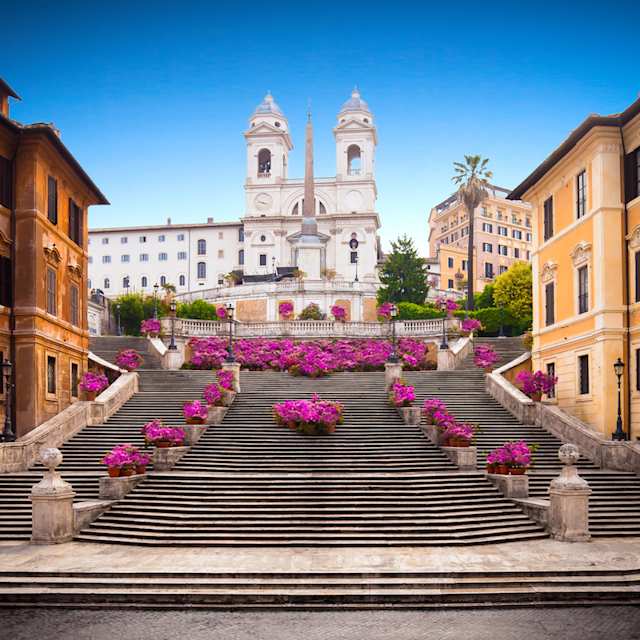
Spanish steps lined with pink azaleas at sunrise, Rome
Another must-do is to climb the famous Spanish Steps for some wonderful views of Rome. At the top of the 138 steps, you can see across the whole city, picking out the dome of St.Peter’s Basilica set against the surrounding hills. Unsurprisingly, it’s the perfect location for sunset, proving very popular with romantic couples. It’s also the longest and widest set of steps in Europe, which means you just ticked off another very obscure bucket list item. Thank us later.
Built in the early 18th-century, the staircase is a popular outdoor venue for cultural events, particularly during the summer months. Concerts and art exhibits are often held here and in the nearby Piazza di Spagna. Around the area, you’ll find some of Rome’s best shopping, with high-end boutiques and designer stores lining the streets.
Insider tip: Go early in the morning to avoid the crowds. Afterwards, stop at Babington’s Tea Rooms at the foot of the steps. Founded in 1893, it's a quintessentially English tea shop offering teas from all around the world – ideal if you're missing your morning brew.
Toss a coin in the Trevi Fountain
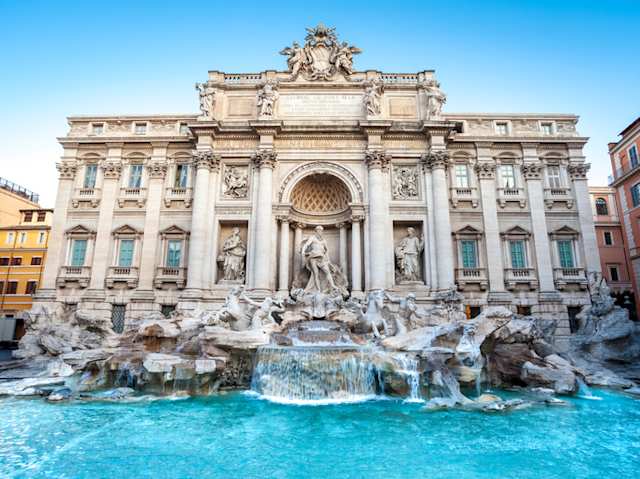
Trevi Fountain in the morning sun, Rome
Not too far away from the Spanish Steps, you’ll find the Trevi Fountain – perhaps Europe’s most beautiful and most famous fountain. Completed in 1762, this is a Baroque masterpiece of art and sculpture with many intricate details to boggle the mind. Whatever time of day you’re visiting, it’s a great, central location – although it's very popular with tourists, so expect lots of crowds. At night, the fountain is illuminated, making it all feel rather romantic.
Before you leave the Eternal City, remember – according to local legend, if you toss a coin from your right hand over your left shoulder into the Trevi Fountain, you’ll ensure your return to Rome someday. Who’s saying no to that?
Insider tip: The money from the fountain is collected daily by the city and goes towards charities and those in need. Why not bring a few extra coins with you? The first toss may guarantee safe passage (and a safe return to Rome), but according to the film Three Coins in the Fountain, the second coin brings a new romance and the third promises wedding bells on the horizon.
Explore the Roman Forum
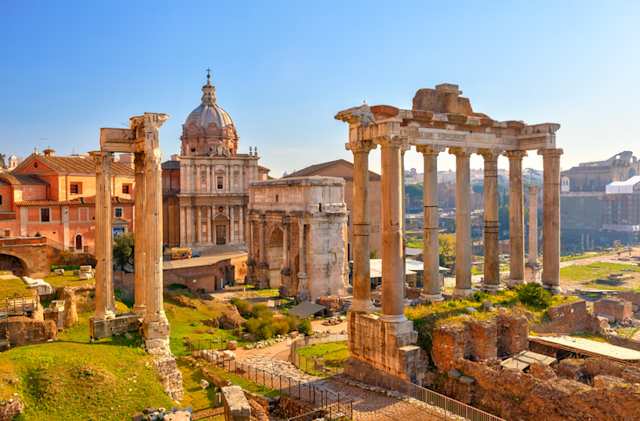
View of the ruins at the Roman Forum, including The Temple of Saturn and The Curia, Rome
No, not the type you might find online for useful travel tips – we're talking about the public square, which was the centre of political and social life in Ancient Rome. For history and culture vultures, this place is the real deal. It’s the site of some of the most important events in Roman history, including triumphal processions, public speeches and political debates.
While you can explore the site yourself, we recommend taking a guided tour so you can really get to grips with the history here. The Roman Forum is home to some of the most iconic examples of ancient Roman architecture, including the Temple of Saturn, the Arch of Titus and the Temple of Vesta – all of them significant and interesting in their own ways.
Insider tip: If guided tours aren't your thing, we suggest bringing a guidebook, instead. There aren't a lot of signs or infographics, so it's easy to walk past some important features and not understand exactly what you're seeing. Wear comfortable shoes, too – you'll be walking on uneven cobblestones.
Get to know Trastevere

A picturesque street with cobblestones and vines in the historic Trastevere district, Rome
If you're looking for something a little different to the classic tourist trail, Trastevere is the place for you. This charming neighbourhood located on the west bank of the Tiber River has done well to cling to its centuries-old working-class roots. Bohemian in nature, the narrow streets, cobblestoned alleys and colourful buildings are a testament to preserving the traditional Italian character.
You'll be pleased to know it's also home to some of the best, most traditional and innovative bars, cafes and restaurants, as well as some great craft beer pubs and artisan shops. At night, bars and clubs are open late, meaning it's vibrant and bustling all hours of the day.
Insider tip: Don't miss a visit to the 12th-century Basilica di Santa Maria. Often overshadowed by St. Peters, it's home to Cavallini mosaics and jaw-dropping frescos. And, if you'd like to see the last remaining Cavallini fresco in Rome, head over to The Basilica di Santa Cecilia and ring the bell for a peek at The Last Judgment.
Admire the Pantheon

The exterior of The Pantheon captured at dusk, Rome
We make no secret of the fact that a lot of the things to do in Rome are based around ancient history and architecture. You simply can’t ignore it in a city of this prominence, age and beauty. The Pantheon is no exception to the rule. In fact, despite standing for 2,000 years, it’s perhaps the most well-preserved monument from ancient Rome.
It was originally built as a temple dedicated to the pagan gods of Rome. Nowadays, it's a Catholic church. Inside, you'll find an astonishing array of artistic treasures, including stunning frescoes, intricate sculptures and marble flooring. The highlight, however, is the oculus – a circular opening at the top of the dome that allows natural light to flood into the interior.
Insider tip: While The Pantheon is free to enter, you'll need to book a time slot on weekends. Since it's an operating church, there's also a dress code. Much like the Vatican, leave the short skirts, shorts, and sleeveless tops for another day.
Head out of town on a day trip

Cascading waterfalls and ancient tunnels of Villa Gregoriana in Tivoli, a day trip from Rome
Being the capital of Italy, it's no surprise to learn that Rome is incredibly well connected when it comes to public transport – the rail network in particular. If you've had your fair share of Gladiators and gelato, there are plenty of day trips to enjoy.
One of the best destinations is Tivoli. Just an hour east of Rome, it's been a popular holiday destination since the days of the Roman Empire. The 16th-century Villa d'Este is a real highlight here, especially the garden, which is considered one of the best in all of Italy. You'll find a musical fountain, waterfalls and streams all flowing among a fine example of Italian Renaissance garden design.
Another popular day trip is Orvieto, just one and a half hours north of Rome. This Umbrian hill town is a fascinating glimpse into what medieval Italy was like, with its glorious Duomo and narrow streets. The Umbrian cuisine is well worth a try, too, with local specialities like truffles, wild boar and handmade pasta, polished off with wines from the nearby vineyards.
Insider tip: While in Tivoli, swing by Villa Gregoriana. It's not as famous as its neighbour, but the gardens are remarkable – we're big fans of the waterfalls, ancient acropolis and the hiking trails through the rustic gardens.


